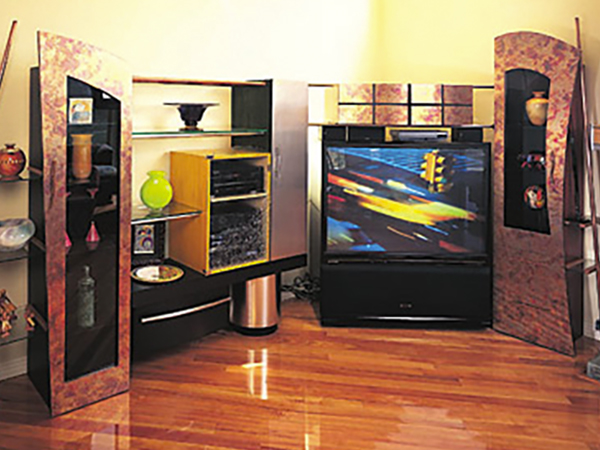
It would please Michael Ireland, if your first reaction – upon seeing one of his pieces – was something like, “Wow! I’ve never seen anything like that before!”
Not that he doesn’t have his influences – but with titles like “Bad Hair Day” and “Glass Half Full,” his colorful, unique furniture takes big strides back and forth across the line that usually separates function and art. Yes, each piece is basically made of wood, but he may use blue stain, incorporate hand-hammered copper, or install a remote controlled motor that opens up a piece!
And even when the reaction is more like “What the heck is that?” once people begin to interact with the piece and realize its “purpose”, some stick around to learn more and maybe even buy. And even with prices in the thousands of dollars, Michael’s work sells briskly at Southern California art galleries and earns him a good living.
Where did it start? Though he’s kind of a late bloomer as a professional, Michael thinks it began when he discovered whittling as a Boy Scout and first appreciated the value of handwork His first real job, as a tool and die maker for Boeing in Wichita, Kansas, gave him a certain mechanical knowledge and understanding of how to plan and put things together. Then about 20 years ago, ending up in San Diego, he stumbled into a corporate career. And there he stayed until he got downsized six years ago. He sent out a few resumes, but his heart wasn’t in it. His wife’s own corporate career was rolling and she suggested he try something he really loved.
“We even got the book “Do What You Love and the Money Will Follow” by Marsha Sinetar,” Michael recalled. “It was a big influence on our decision.”
Michael had done a little woodworking as a hobby, so he headed down to his workroom. Using an old Sears’ table saw, a Inca band saw (that he still uses), and scraps of wood, he designed and assembled little tables and stands. As Michael puts it, the pieces were on the woody side of things ? definitely derivative of James Krenov.
Michael described what happened next: “I literally threw them in the back of a car and drove around to galleries and garden shops, asked whoever was in charge to take a look at these things. Two local galleries took the piece and sold them almost immediately. So, I whipped up a little portfolio of other things I could do, and within six months, I had two armoire-size jobs and within a year, I was doing dining room tables on referral. And from that day to this, I haven’t advertised as such – until very recently. I’ve been luckily successful.”
His style evolved greatly from there, but some things – his use of color, exotic woods, and curves – have been constants from the beginning. What has influenced his work? With titles like Astro’s Dog House, it’s not surprising the Loony Tunes cartoons, particularly those of the forties and fifties, made a big impression on him.
“As Bugs or Daffy ran through a house, there was always this cartoon furniture in the background. You might call it crude, but it invoked everything from Chippendale to Modern and made great use of color. Today, everything I do has a cartoonishness to it.”
Other more recent influences are African tribal designs with a dash of Japanese color and curves. And aside from the early influence of James Krenov, Gary Knox Bennett and John Makepeace have been influential in his work.
“I’ve gotten to know Gary and even hang out with him. I like his use of color and odd things put together and juxtaposed. I look at his work and say, ‘you can do that?’ He doesn’t try to make things perfect and I don’t try to either.”
Each piece typically starts with a crude pencil sketch, and then he starts putting the pieces together. The further out the design gets the more it tends to be on speculation. But for some pieces, particularly for commission, he’ll make a scale model.
“Then the client can walk around it and see the color ? I try to use the same kind of wood,” Michael explained. “They think the model’s cool and half of them end up keeping the model and have it by the finished piece. The models I’ve kept are great for attracting attention at shows.”
Most of those clients have been reached through galleries. His work has found homes up and down the California coast, more recently in Texas, and in Chicago, and one’s soon going to St. Louis. He glad to finally be getting some exposure outside California.
“While there’s plenty of money in southern California it’s relatively uneducated money and it’s harder to sell in this market. And the money I make is balanced out by how expensive it is here. Places like Philadelphia, Chicago, and San Francisco are more receptive. New York’s a tough nut to crack. There’s a definite schmooze factor. I sometimes think about the Northwest, but it’s very woody up there and they might say ‘Oh ? you stained it blue?'”
Like most high-end woodworkers, Michael’s web site Lost World Furnishings serves more as a online portfolio that shows people what he can do, than as a sales vehicle.
“The name comes from a favorite movie from the 50s. My wife and I thought it sounded cool, but when you do a search, the first 80,000 reference are to Steven Spielberg’s more recent movie. I’m probably going to be changing it to my business name “Michael Ireland Design.”





